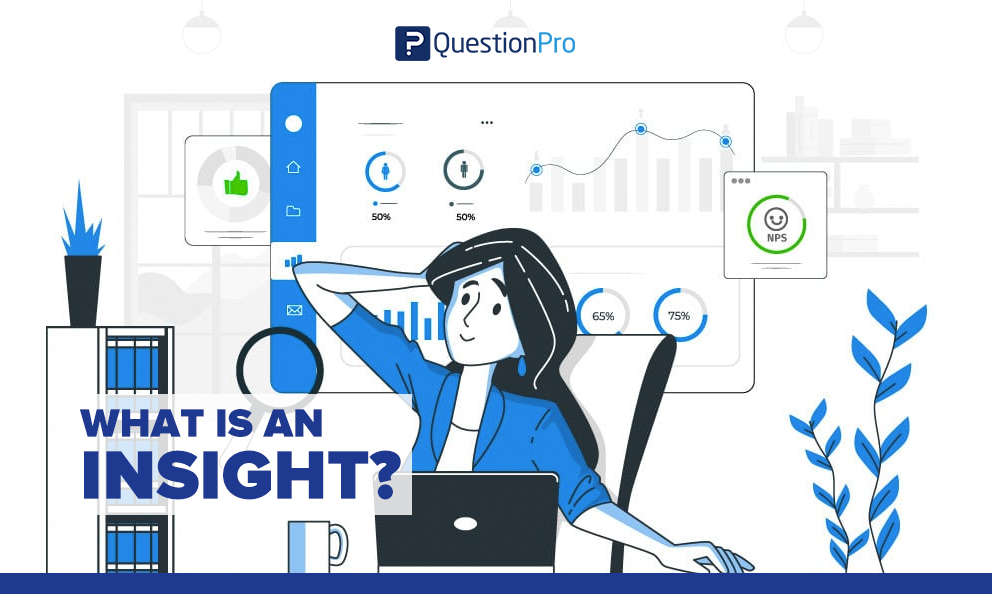
Understanding what an insight is and how to generate it correctly is crucial in market research. Insights allow us to grasp key information about what consumers seek, helping identify business opportunities and develop impactful communication strategies.
In this article, we have gathered all the necessary information to understand an insight, its meaning, and everything related to this concept. Although it is simple to define, it can be complex to grasp fully. We hope this helps you!
What is an Insight?
An insight is defined as the aspects and characteristics of consumer and customer behavior that are typically “hidden.” These need to be deduced by cross-referencing information and analysis.
Insights consist of any piece of evidence relevant to explaining how and why people become consumers of a brand, adding or destroying value.
Generating insights involves making observations and contextualizing information about consumer value, behavior, habits, circumstances, attitudes, market, or environment. These insights have the potential to change a company’s actions toward success.
They are not just isolated facts or figures but discoveries presented in the light of broader contextual understanding.
Where Do Insights Come From?
Now that you know what insight is, let’s look at the sources from which data can be drawn for generating insights, including:
- Customer Databases: These can tell us the identity of our consumers, the nature of our relationship with them, their transactions, and the value of those transactions.
- Internal Data: Various departments within a company can provide significant pieces of knowledge, such as employee interactions, operational constraints, financial implications, and customer complaints.
- Market Data: Companies need an external perspective on market volume and value, their market share, and broader trends (consumer, demographic, economic, technological, etc.).
- Consumer Research: Market research is the backbone of generating insights for many companies, whether quantitative, qualitative, ethnographic, semiotic, or through other methods. This involves talking to consumers to understand why they act the way they do and under what circumstances they might act differently.
Accumulating multiple insights builds an aggregated understanding by cross-referencing evidence and discoveries from various projects and sources, reflecting on their connections, and investigating their contradictions.
Types of Insights
Generally, we can identify three main categories of insights in market research:
- Consumer Insights: These insights involve understanding the audience, their needs, interests, desires, and consumption process. The goal is to know not just what they do but why they do it.
- Competitive Insights: These insights require broadly defining competition. It’s about observing what competitors are doing well or poorly and what people respond to or ignore.
- Cultural Insights: Understanding the culture surrounding an audience and competitors can also yield valuable insights, such as popular influencers, the language used, historical context, emerging trends, and expected behaviors.
Why do we use insights?
Actionable insights bring significant advantages to any company’s product or service, from attracting more consumers to gaining a larger market share. Some main benefits include:

- Engaging More Consumers: Insights allow for automated, relevant recommendations that help consumers get what they want, providing a personalized service.
- Building Trust: By understanding consumer habits and behaviors, brands can offer helpful recommendations, deepening relationships and earning customer trust.
- Increasing Sales: Engaged and trusting customers are more open to new offers and services, boosting sales.
- Successful Product Launches: Using insights for product development ensures the product meets the defined audience’s needs, increasing adoption and commercial success.
- Effective Advertising and Marketing Campaigns: Insights help tailor marketing strategies to increase brand awareness, gain new customers, or retain existing ones.
How to Build an Insight
A solid strategy for generating insights involves a multidimensional process including:
- Defining Data Objectives: Know what you want from your data, addressing specific needs and measuring project success.
- Creating a Framework: Visualize data to tell a story, making numerical data graphical or transforming unexpected data for easy understanding.
- Examining Different Perspectives: Different people see data differently, so involving multiple perspectives can generate actionable insights.
Tools to Obtain Insights
The choice of methodologies and techniques will depend on the research objectives, but commonly used tools for generating insights include:
- Databases from government and non-government institutions
- Focus groups
- In-depth interviews
- Surveys (both online and offline)
- Sample lists for higher quality audience construction
- Online communities
These tools can work together to extract precise information, providing high value for research objectives and helping to understand consumer behavior strategically.
Examples of Insights in Use
Here are some cases where well-known brands have used insights to achieve commercial goals:
- Brand Recognition and Engagement: Netflix uses consumer-generated insights to perfect user experience, leading to high retention and word-of-mouth recommendations.
- Target Audience Improvement: DirectTV identified a crucial audience segment through research. Using postal data to target new homeowners with customized offers, DirectTV’s standard page performed better.
- Sales Increase: Nike’s Nike Plus membership program uses insights to offer personalized rewards, improving product understanding and sales prediction, leading to increased sales.
We recommend you read: Nike Customer Experience
Get Actionable Insights!
Insights are like the holy grail of market research. To obtain reliable insights for your research objectives, it is essential to develop methodologies and use the most effective tools.
At QuestionPro, we offer the best tools for generating insights. If you’d like to learn more about them, contact one of our online advisors at no cost and get ready to obtain the best insights for your next research!







